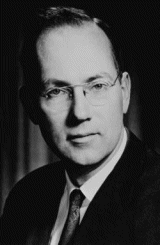Charles Townes

Inventor of the Laser
Nobel Prize 1964
As a student at Caltech, Townes was told to give up physics by his doctor because all the reading was too much for his eyes.
As a compromise, he concentrated on experimental physics, thinking working with instruments and equipment would be less of a strain.
This turned out to be a fortuitous decision,
as the development of the maser (the microwave version of the optical laser)
required a unique blend of experimental technique and theoretical knowledge.
In the 1940s, Townes worked on radar as part of the war effort. MIT's radiation lab had successfully produced working radar
at the 10 cm wavelength, and even 3 cm, but the military told them to try and produce 1.25 cm radar.
The point, of course, is that the smaller the wavelength, the more precise the resolution of what the radar can resolve.
Townes told Washington that 1.25 cm radar could not work, because that wavelength of radiation coincided with a frequency
at which water vapor absorbs radiation...but the military replied that the decision had already been made and they could not stop.
Naturally, when it was built, it did not work. The radar beam went out a couple of miles, and then would fade out,
being absorbed by water vapor which was present in the atmosphere.
Building on the knowledge gained by the failed microwave radar,
Townes continued on in microwave research after the war.
Ammonia also has a 1.25 cm absorption line, and Townes made
the first maser using ammonia as the masing material.
Today, the laser is ubiquitous, and sometimes appears as if it
can be made from almost anything...Arthur Schawlow, Townes
brother-in-law, to illustrate this, tried to make an edible laser,
from Jell-O...although that did not work, by using just regular
gelatin and fluorescent dye, the required edible laser was made.
Feynman once remarked to Townes privately, as they were discussing the laser,
that the way to tell a great idea is that, when people hear it, they say "Gee, I could have thought of that."
Perhaps. But the history suggests otherwise...
Columbia theorist L.H. Thomas told Townes the maser could not work.
After Townes demonstrated it, Thomas stopped talking to him! The great Bohr
told Townes it could not work (due to line broadening) -- even after it had
been demonstrated. Von Neumann's initial reaction was also that it could not work,
but on being told it had been done, went away and after 15 minutes of thought decided that yes, it could.
The reason Bohr, Von Neumann, Thomas and others thought it could not work of course is due to the
time-energy uncertainty principle. (To remind you, the time-energy uncertainty principle roughly
says that if a time evolving state has been in existence for a time t, then the uncertainty E in its
energy is such that Et >= hbar/2) Now, the time a photon spends in a maser/laser cavity is on the
order of .0001 seconds, and so the uncertainty in its energy should have been greater than what Townes
was claiming (Laser light has a very high spectral purity which translates into a very low uncertainty
in the energy of its photons)...However, as there are many molecules in the masing or lasing medium,
we do not know which molecule has underwent a transition, and so we do not learn the energy or frequency
of any particular molecule from the laser light. Hence, the uncertainty principle is not being violated.
A slightly similar situation occurs in the Mossbauer effect.
Here is a video of Townes discussing the history of the laser.